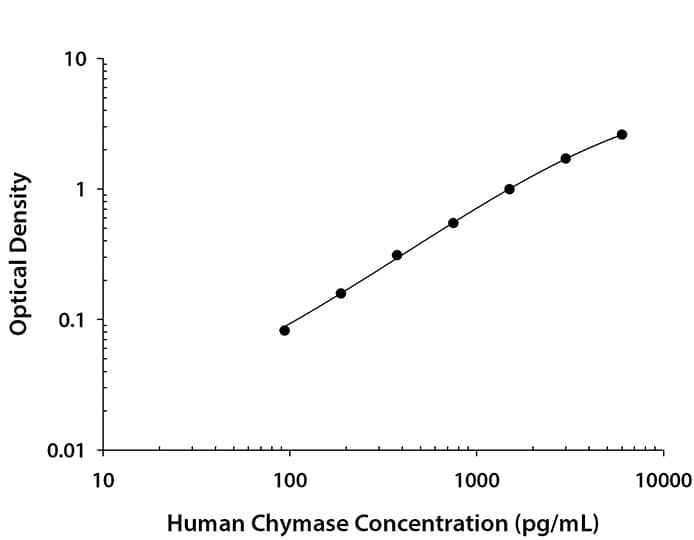Human Chymase/CMA1 Antibody
R&D Systems, part of Bio-Techne | Catalog # MAB40991

Key Product Details
Species Reactivity
Applications
Label
Antibody Source
Product Specifications
Immunogen
Gly20-Asn247
Accession # P23946
Specificity
Clonality
Host
Isotype
Scientific Data Images for Human Chymase/CMA1 Antibody
Human Chymase/CMA1 ELISA Standard Curve.
Recombinant Human Chymase/CMA1 protein was serially diluted 2-fold and captured by Mouse Anti-Human Chymase/CMA1 Monoclonal Antibody (Catalog # MAB40991) coated on a Clear Polystyrene Microplate (DY990). Mouse Anti-Human Chymase/CMA1 Monoclonal Antibody (MAB4099) was biotinylated and incubated with the protein captured on the plate. Detection of the standard curve was achieved by incubating Streptavidin-HRP (DY998) followed by Substrate Solution (DY999) and stopping the enzymatic reaction with Stop Solution (DY994).Applications for Human Chymase/CMA1 Antibody
ELISA
This antibody functions as an ELISA capture antibody when paired with Mouse Anti-Human Chymase/CMA1 Monoclonal Antibody (Catalog # MAB4099).
This product is intended for assay development on various assay platforms requiring antibody pairs. We recommend the Human Chymase/CMA1 DuoSet ELISA Kit (Catalog # DY4099-05) for convenient development of a sandwich ELISA.
Formulation, Preparation, and Storage
Purification
Reconstitution
Formulation
Shipping
Stability & Storage
- 12 months from date of receipt, -20 to -70 °C as supplied.
- 1 month, 2 to 8 °C under sterile conditions after reconstitution.
- 6 months, -20 to -70 °C under sterile conditions after reconstitution.
Background: Chymase/CMA1
Chymases are a group of chymotrypsin-like serine proteases secreted by mast cells (1). They are synthesized as inactive precursors containing a 2‑residue propeptide, which needs to be removed by dipeptidyl peptidase I/cathepsin C for the enzymatic activity (2). Human Chymase encoded by the CMA1 gene is known to be involved in hypertention and heart failure through its ability to convert angiotensin I (Ang I) to angiotensin II (Ang II), which plays a key role in the regulation of arterial pressure (3). In addition, it is also important in physiological and pathological conditions including inflammation, fibrosis and processing of cytokines (4). Therefore, designing a specific inhibitor for Chymase activity has been a pharmacologic strategy to develop therapeutic agents.
References
- Caughey, G.H. (2004) in Handbook of Proteolytic Enzymes. Barrett, A.J. et al. ed. p. 1531, Academic Press, San Diego.
- Murakami, M. et al. (1995) J. Biol. Chem. 270:2218.
- Miyazaki, M. and S. Takai (2006) J. Pharmacol. Sci. 100:391.
- Nakajima, M. and N. Naya (2002) Jpn. J. Pharmacol. 90:206.
Alternate Names
Gene Symbol
UniProt
Additional Chymase/CMA1 Products
Product Documents for Human Chymase/CMA1 Antibody
Product Specific Notices for Human Chymase/CMA1 Antibody
For research use only
